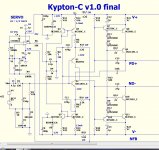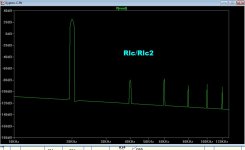Whenever I have compared models like that to datasheets, I was always disappointed. I don't remember exactly which models I checked. Cordell's models were made using data from real transistors and they use a new type of model that's superior. Yet, even the superior model is flawed, so while Cordell's models have accurate capacitance modeling, even they won't be accurate in the crossover region.
So far anyways, Cordell's models are the best that I know of.
So far anyways, Cordell's models are the best that I know of.
Nice job and I agree wholeheartedly on that statement being BS 😱Mr. Self says a symmetrical VAS is inferior to a current sourced one. BS !!
"V" is a "gain monster" with good PM. Very stable.
A text file downloaded from here. I'm attaching it.
I collected those models during the time I started to use LTspice. Now I use Cordell's models mostly like laterals and verticals, BC5xx.
Thanks,
As I said, I am just learning to use ltspice. I don't use it for designing. I use it mainly for trouble shooting. It gives petty good voltage references which are a big help in chasing down errors. Those models in Dado's file seem to work fine in that regard. I will use Cordell's models from now on. I have that file as well.
As I said, I am just learning to use ltspice. I don't use it for designing. I use it mainly for trouble shooting. It gives petty good voltage references which are a big help in chasing down errors. Those models in Dado's file seem to work fine in that regard. I will use Cordell's models from now on. I have that file as well.
I don't know anything about simulation....i can simulate this in real world.😉
Please Os ,post a pcb here and i will make this alive.
Please Os ,post a pcb here and i will make this alive.

I used BV's CFB summed cap trick ...
OS
I tried many FB variants and this one is unlistenable, very bad. Caps in simm and in reality are way appart. I found out better FB ... 😉
I tried many FB variants and this one is unlistenable, very bad. Caps in simm and in reality are way appart. I found out better FB ... 😉
And that better better feedback is...?
And that better better feedback is...?
The secret sauce is only available in Lazy Cat's 'First One' commercial venture, which is a closed proprietary design available as complete ready-to-use modules, not for DIY.
He seems to have a habit of poking in on anything that is VSSA at the core solely to tell us how he's done it better. He may well have done it better but you'll have to buy his 'First One' to find out. He will keep any improvements to the VSSA architecture obfuscated for his commercial activity, which is fine. If he has some genuine design details that are an improvement it is within his right to hold them close, or even to misdirect if it helps protect his interests. However, such 'teasing' I think we could all do without.
He will never tell us anything, not even conceptually, never mind specifics. Like Terry said, it's bait.
Look in Lazy Cat's signatureAre there any detailed and extensive specs of this kit you talk about?
The secret sauce is only available in Lazy Cat's 'First One' commercial venture,
He will never tell us anything, not even conceptually, never mind specifics. Like Terry said, it's bait.
I don't think there is "much" thing left in the VSSA. Amplifier is only a very small portion of audio chain. What matters is how the amp interacts or is in synergy with the other components in the audio chain to produce the final sound. I mean, whatever the amp is, what more important is to choose the matching other components.
For example, 1K/10K at the input is crucial for VSSA measured performance (THD, clipping). But they are also problems. In term of input impedance for example, 10K is rather low, meaning a special preamp is needed, or at least a buffer. I saw an opamp as a buffer in the potentiometer in the later build. What!? Opamp?? What is the power supply?? How about comparing with DCB1 for example?
Funny, I use the DCB1 as a buffer in my A/B setup. Some folks question whether that affects the comparison value.
I tend to prefer THB to VGH, because the LG of the PST is lower than the DN of the TC3. Of course, this is only true when you don't add a JSK to the BZJ.
I have to agree that Total Harmonic Blurr sounds preferrable to Very Greasy Harmonics. Ofcourse the Loop Gain of the Positive Sigma Transformer is lower than the Dynamic Noise of the Transitional Compensation type 3. Adding Junction Silicon Keflar around the legs of a Bipolar Impedance Junction is Always a good idea to improve low bound dynamics.
"seecret sauce" ... what BS !
(below 1) - I ran the cat's original FB scheme. I still get 8ppm and the same
basic performance.
The single digit performance is due to the VAS/mirrors (80+db CLG)
, not bloody "secret sauce" (go to Mcdonald's for that)!
In fact ,using (Rlc ,Rlc2 - R8) , the H3 was more (below 2) than with a summed FB scheme (R8 only). H2 was dominant with the "BV" FB.
Also, 50hz performance was inferior ,too.
Well , I'll leave it to Thimios ... The prototype will have both compensation
types and both feedback paths (jumper Rlc/Rlc2 and include R8=39R).
I bet either way will sound fine .... not "unlistenable" ($$$$$) 🙄 .
(Ohhh , voodoo magic - unobtainium).
OS
(below 1) - I ran the cat's original FB scheme. I still get 8ppm and the same
basic performance.
The single digit performance is due to the VAS/mirrors (80+db CLG)
, not bloody "secret sauce" (go to Mcdonald's for that)!
In fact ,using (Rlc ,Rlc2 - R8) , the H3 was more (below 2) than with a summed FB scheme (R8 only). H2 was dominant with the "BV" FB.
Also, 50hz performance was inferior ,too.
Well , I'll leave it to Thimios ... The prototype will have both compensation
types and both feedback paths (jumper Rlc/Rlc2 and include R8=39R).
I bet either way will sound fine .... not "unlistenable" ($$$$$) 🙄 .
(Ohhh , voodoo magic - unobtainium).
OS
Attachments
Last edited:
Yes, MagicBox, this is exactly what can understand people like me, for whom English is not the native language, with such an abuse of acronyms all the two words.
Ostripper, and some others, can-you please make an effort:
"H2 was dominant with the "BV" FB."
Ostripper, and some others, can-you please make an effort:
"H2 was dominant with the "BV" FB."
Last edited:
- Home
- Amplifiers
- Solid State
- Slewmaster - CFA vs. VFA "Rumble"


